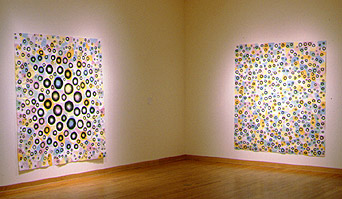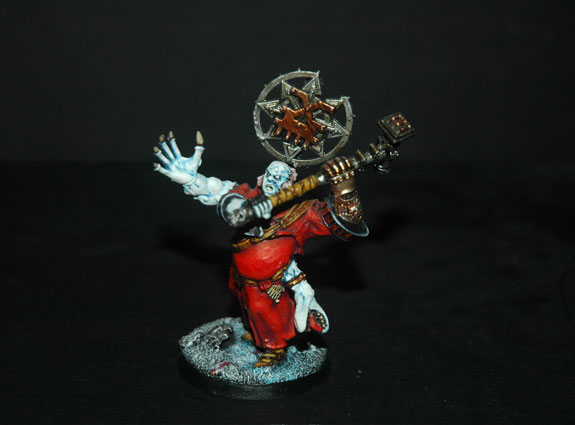View current page
...more recent posts
Is it possible to contribute to a Tom DeLay legal offense fund? That sleazy criminal, sorry alleged criminal, has all the money in the world to out-lawyer and out-maneuver the poor beleaguered public official who finally indicted him. Like today, his successful tactic of getting the judge in his money laundering trial replaced because the man made some contributions to the Democrats.
What is it going to take to get rid of DeLay, the human crab louse? I'd give a hundred dollars to Ronnie Earle in Austin. Anybody else?
 An excerpt from the interview Cory Arcangel did with me at Rhizome.org [dead link - see below]:
An excerpt from the interview Cory Arcangel did with me at Rhizome.org [dead link - see below]: "The computer still has the shock of the new, or the shock of the bad in some cases. Art world folks know painting, photo, and printmaking lore, but are less secure--myself included--knowing what constitutes talent on the computer as opposed to some easy-to-do technical trick. I thought because everyone had Paint or the equivalent on their computer and had at least made a mark or spritzed the spraycan, they could see that I was doing something more ambitious with it. I was thinking of this guy in New Mexico who made perfect perspective drawings using an Etch a Sketch. If I could draw La Femme Nikita from scratch on this toy program and actually have people (well, guys) say she's hot, then a landmark would be achieved for both Paintbrush and the computer. The problem is I drew her so realistically people assumed I was running a photo though a pixelating filter.
"When I talk about craft on the blog, just to make it clear, I'm not talking about drawing ability but things like mosaics and needlepoints that relate to the computer on a much more fundamental image-making level, the grid level. I love the cross-stitch patterns and beadwork you can find online based on MSPaint drawings. In the late '90s I was impressed by the writing of cyberfeminist Sadie Plant, who opened up for me a whole organic, non-analytical way of looking at computation. She traces digital equipment back to one of its earliest uses, as punchcards for looms, and talks of the internet as a distributed collaborative artwork akin to traditionally feminine craft projects At the time I was drawing and printing hundreds of spheres at work and bringing them home, cutting polygons around them, and then taping the polygons back together in enormous paper quilts. In my press release for the Derek Eller show we called it 'corporate tramp art.'"
Update: New Link to Cory's interview with me.
Continuing my unbirthday celebration, this image arrived by email, with the caption INVINCIBLE. Another gem. Thanks to Diana and Matthew, and Luke for the badass figure.

"Permanent Chase" [mp3 removed]. The second in a projected series of "quieter" pieces for drum machine and Sidstation. The first was "Clip City" [mp3 removed]. They're not really quieter, they're just not as compressed as my other audio so they don't explode out of a pair of computer speakers. Bump the volume a bit and they're "loud enough." [Update: I've since made both of these tracks louder; these are the quiet versions.]
On "P. C.," yes, the lead is repetitive and dumb. It's supposed to be kind of a joke. And the key change at the end is also a bit of a joke after all the repetition (bad musicians use gratuitous key changes to hide a thin song). For those who might think I use only presets and dry, out of the package synth sounds, generally I like'em but these pieces actually got a fair amount of tweaking. As I explained in an earlier comment:
I've been using controllers (knobs and curves) in a lot of the work. Mostly cutoff filter/resonance, some LFO vibrato and sweeps. In "Permanent Chase" I used a controller to detune one oscillator, that's how I did my "key change." The drums in "Clip City" were filtered using LFO to change the envelopes, and "Permanent Chase" had three 45-second "movements" each using its own distinct filter settings (the Mutator effects filter in two of them plus Spektral Delay in the third). Each part was mixed down separately, run through noise reduction then cross faded so it appeared to morph out of the one that preceded it. This was all in the drums. The Sid had chorus plus the detuning. Maybe I should be proud that everything still sounds "out of the box."
My birthday falls, um, around Halloween (we ain't all sentimental on this blog so that's all I'm sayin'). Stephen and Andrea carved a pumpkin in my honor and named it Tom. Thanks, guys, it's beautiful.

I've been having an interesting discussion offline about the "confusing" nature of my recent music. A listener suggested that if it's German trance or house I'm going for, it should be more sophisticated and varied, with more filtering, pitch-shifting, layering of sound, use of quantizing to give more swing to the rhythm, and less use of factory presets. If it's conceptual art (as in Yoko Ono or Philip Glass minimalism--my examples), it should be a lot clearer that's the frame of reference. As it is, the listener says, the music is somewhere in the middle and needs to lean one way or another.
Maybe what set him off was a piece I just posted, called "Permanent Chase," which took a one bar "found" melody and pretty much beat it to death. Composing for me isn't about spending hours in the lab creating new synth sounds--it's more about taking what's there and using it to just to the point where you're about to scream and then tossing in one little change that brings some closure. Maybe with that piece I failed (too many bars before the goofy key change? maybe if snipped out about 8-16 bars?). I've pulled it pending further study 'cause I'm not sure myself.
Generally speaking, though, I like that middle ground he's talking about. My visual work has always occupied a realm somewhere between "failed commercial art" and "conceptualism that's too stupid to look at." I certainly started out doing music with that mindset. I've been grinding out so much of it lately that maybe it's starting to get "good," as in, one wants to hear it be "better." That may be the time to walk away from it. My hearing would probably thank me.
Steve Gilliard wrote this imagined dialogue between Bush Senior (41st president) and Junior (illegitimately elected 43rd). The substance is there, but this conversation would never occur in a patrician family like the Bushes'. 41 would communicate his concerns to Barbara or one of Bush's brothers, who would pass it along to Junior. An even more likely scenario is that Senior would weakly, passively say nothing and Barbara (possibly after a few cocktails) would instigate and deliver the lines below:
The Bush family is sitting in the White House family quarters.
41 is standing, 43, sullen and silent while Barbara looks on
41: Son, you're in real trouble now
43: Whatever
41: No, son. You're in this up to your ass and I cannot fix it. I thought Dick would look out for you, but his ass is cooked as well.
43: I'll handle it.
41: Handle what? What are you going to handle? A prosecutor?
43: I'll pardon them
41: No you won't. You wanna be impeached like Clinton? People don't like you, George. You're mean and crude and this day has been coming for years.
[etc]
Cory Arcangel did an interview with me, published today at Rhizome.org [dead link - see below]. Thanks to him for the good back-and-forth, once I got my rather long-winded biographical reminiscing out of the way, and Marisa Olson for her editing. (Update: Marisa just reposted the lead-in to the interview--newsGRIST's reblogging of Rhizome's original post.)*
It was great to talk about music with Cory, whose work I really like. The 8-Bit Construction Set LP--which he made with the BEIGE crew--still gets props, most recently in an article in Wired. Also "Rudy Tardy and the Slowes," his solo music that I posted here a while back, continues to be listened and linked to, just this month by an Italian site called neural.it. We also talked about visual art--Chris Ashley found a good excerpt that I will probably post as a teaser; see the comments for now. In fact, I'll probably end up putting up goodly chunks of the interview here as I continue to have second thoughts and/or run out of new things to say.
At the end of the interview we discussed what it means for an artist to be "all over the place," i. e., not just sitting in the studio turning out objects in that same signature style. I gave the best answer I could--it's tough. I understand the benefits of that kind of forced discipline, and go in and out of periods of Tim Hawkinson-like focus myself, but I hate that it's the only measure of commitment or worth as an artist. One hope I had in starting the blog was that the various diverse activities documented here could be seen as feeding into some kind of overall artistic sensibility. But for all the lip service paid to the idea of cross-disciplinary practice by curators, etc., it's still viewed with skepticism. In the art world's collective unconscious, the prime model is still a romantic primitive like Albert Pinkham Ryder, painting all day and sleeping on the streets at night in a rolled up carpet. And doing nothing else.
reposted with more verbiage...and ranting
Update: New Link to Cory's interview with me.
*Update 2: Marisa Olson's lead-in is now at http://rhizome.org/editorial/2005/oct/31/tom-moody-chats-w-cory-arcangel/
